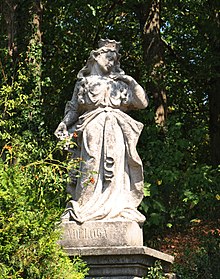Hadeloga from Kitzingen
Hadeloga von Kitzingen (also Adeloga , Hadelauga , Adelheid ; † April 18, 750 probably in Kitzingen ) was the first (lay) abbess of the Benedictine monastery of Kitzingen from around 745 , later she was canonized. Today the existence of the Hadeloga is considered proven, but its abbatiate in Kitzingen is only documented by several saints' lives.
Life
In the legend of the founding of the monastery, St. Hadeloga is mentioned as the central figure. The founding legend is: Princess Hadeloga, also Adelheid, was a daughter of the house keeper Karl Martell and his wife Kunechild. She was raised on the royal castle on the Schwanberg. She turned down all the marriage applicants because she wanted to become a nun. The father, Karl Martell, suspected, however, that his daughter had a love affair with his court chaplain and expelled both of them from his court.
The two wandered around and founded a monastery in a forest clearing . The court chaplain donated all of his goods to the young convent and ensured that several nuns moved in , so that Hadeloga became the first abbess. The monastery got its name after the shepherd Kuccingus, to whom Mary appeared and who freed a stolen lamb from the clutches of a wolf. Karl Martell, meanwhile, regretted his harsh actions against his daughter and generously endowed her foundation.
A second version of the legend assumes that Hadeloga was brought up on the Schwanberg on the edge of the Steigerwald. She is said to have held her veil to the wind from the mountain. She wanted to found a monastery where the veil fell. A first attempt failed and Hadeloga called "Villsenah" (much too close, still a corridor today ). On the second attempt the veil landed at a height above the Main . The princess shouted “Much too high!” ( Hoheim was later created here ). The third attempt was more successful: a shepherd named Kitz found the veil on a meadow by the river. He brought her veil to Hadeloga and she founded the monastery.
The legend was handed down and written down in the 14th century by the Kitzingen abbess Anna von Heideck. However, research agrees that Karl Martell did not have a daughter by the name of Hadeloga. Rather, the name is to be associated with the East Franconian aristocratic family of the Mattonen , who founded several monasteries in the area. The family tried to provide for their second-born members.
When the monastery of Hadeloga was founded, it was probably initially just a women's monastery . The women there probably only lived in a loose Vita communis . Only in the course of the renovation of the monastery by St. Boniface did the monastery become a real abbey. With Thekla von Kitzingen, Hadeloga was assigned an consecrated abbess.
The visit of St. Sturmius to the monastery also fell during the presumed term of office of St. Hadeloga . The missionary was on his way back from the Benedictine monastery of Monte Cassino when he was surprised by an illness. He lived for four weeks in the Kitzingen monastery and was nursed back to health by the nuns there. Saint Hadeloga died in 750 and was buried in the monastery church in Kitzingen.
Adoration
Around 820 the mortal remains of the Hadeloga were raised by their successor Schwanhild and Hadeloga was canonized . The feast of the saints is celebrated on February 2nd . The relics of the saints lay in the monastery in Kitzingen until 1525, they were destroyed during the German Peasant War. The veneration is limited to the region around Kitzingen. Hadeloga is the patron saint of fever.
literature
- Klaus Arnold: 1250 years of Kitzingen. From the shadow of the monastery to the city on the Main (= writings of the Kitzingen City Archives, vol. 5) . Kitzingen 1996
- Wilhelm Engel: On the Vita of the Holy Hadeloga of Kitzingen (= special edition of the Würzburg diocesan history sheets 11th / 12th century) . Wuerzburg 1950.
- Helmut Petzolt: Kitzingen Abbey. Establishment and legal situation . Kallmünz 1955.
- Helmut Petzolt: Kitzingen Abbey. Sources and research (diss.) . Wuerzburg 1951.
- Benvenut Stengele : The former women's monastery in Kitzingen am Main (Lower Franconia) . Sulzbach 1897.
- Hanns Zwosta: Villsenah . In: Under the spell of the Schwanberg. Yearbook for the district of Kitzingen 1961 . Kitzingen 1961. p. 117.
Commonscat
Individual evidence
- ↑ Stengele, Benvenut: The former women's monastery Kitzingen am Main . P. 95. While Stengele mentions these figures, the more recent literature does not give an exact date.
- ^ Arnold, Klaus: 1250 years of Kitzingen . P. 16.
- ↑ Holy Legends : Hadeloga , accessed on July 21, 2016.
- ↑ Petzolt, Helmut: Kitzingen Abbey. Establishment and legal situation . P. 70.
- ↑ Zwosta, Hanns: Villsenah . P. 117.
- ↑ Petzolt, Helmut: Kitzingen Abbey. Source and research . P. 27.
- ^ Arnold, Klaus: 1250 years of Kitzingen . P. 12.
- ↑ Ecumenical Lexicon of Saints: Hadeloga von Kitzingen , accessed on July 21, 2016.
| personal data | |
|---|---|
| SURNAME | Hadeloga from Kitzingen |
| ALTERNATIVE NAMES | Adelheid; Adeloga; Hadelauga |
| BRIEF DESCRIPTION | Lay Abbess, Saint |
| DATE OF BIRTH | 7th century or 8th century |
| DATE OF DEATH | April 18, 750 |
| Place of death | unsure: Kitzingen |
